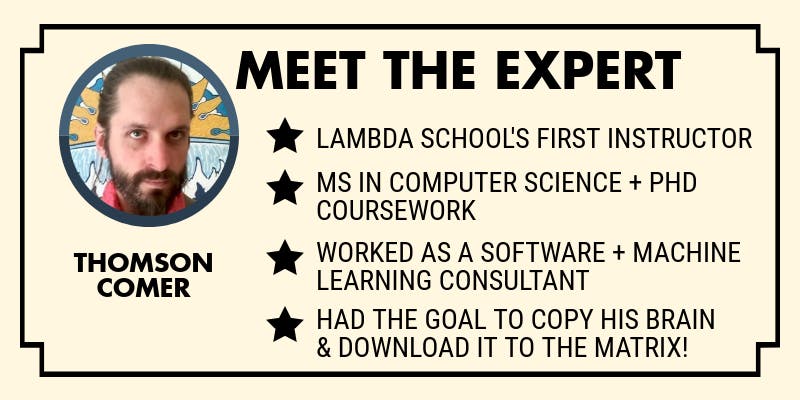Article
What is Artificial Intelligence? A Primer with Lambda School
![]()
Written By Lauren Stewart
![]()
Written By Lauren Stewart
Course Report strives to create the most trust-worthy content about coding bootcamps. Read more about Course Report’s Editorial Policy and How We Make Money.
Course Report strives to create the most trust-worthy content about coding bootcamps. Read more about Course Report’s Editorial Policy and How We Make Money.

Artificial Intelligence encompasses computer science, machine learning, and data science, but what does it all really mean? We spoke with Lambda School’s Director of Machine Learning, Thomson Comer, to get the details. Learn about the history and growth of artificial intelligence, how AI is commonly used today, and see what it takes to succeed in a machine learning course like Lambda School’s Online Data Science Major: Machine Learning!

What is your experience with artificial intelligence?
In 2004, I went to graduate school with the objective of teaching computer science at a small liberal arts college. At the time, I was very excited about artificial intelligence research, and my goal was to be like Johnny Depp in the movie Transcendence – I wanted to learn how to make a copy of my brain and download it to the Matrix. My PhD program covered neuroscience, artificial intelligence, neural networks, machine learning, and computer vision.
I graduated with my master's degree and worked as a software consultant for the last decade. I’ve written ML models professionally for Mersive, Samsung, and Dell, along with IoT, firmware, TV software, front and back end web development, and native mobile apps. I met Ben and Austen on Twitter and leaped at the opportunity to teach at Lambda School. I built the Lambda School computer science curriculum and taught the first two classes.
What is AI and how does it work?
Artificial intelligence is the process of creating simple mathematical models to use on high dimensional data sets. Usually, the data has too many complicated numbers and dimensions for a human to make sense of in a spreadsheet.
Artificial intelligence is really an umbrella term for computerized problem-solving using careful guessing rather than perfect algorithms. In fact, you could say that the entire field of computer science is about algorithms (algorithms are perfect programs that provide a specific solution every time). Artificial intelligence is the study of building algorithms with imperfect solutions. These solutions are better than guessing and are valuable when perfect algorithmic solutions are impossible. Perfect solutions are impossible for most interesting problems. And that's the goal – to produce a computer-assisted solution when it's impossible to get a perfect answer.
What is the relationship between artificial intelligence, data science, and machine learning?
Machine learning and data science are sub-disciplines of artificial intelligence, which is a computer science field that's been studied in academia for close to 60 years. Machine learning passes numbers through numerical models that have been invented over decades of research and are still seeing exciting modern developments. We push this complicated data through a model in order to produce insights from the machine that a human couldn't get without it.
The reality of machine learning is that it's like doing a hundred thousand years of handwritten arithmetic in an hour and then producing insights on that data – a human could never do that on their own.
Data science has more to do with a subset of artificial intelligence called unsupervised learning. In data science, we take a numerical model and we input unlabeled data – data that no human has ever looked at or categorized. It’s then up to a human to look at the inferences made by the data science algorithm in order for us to actually understand and change our business policies.
What is Reinforcement Learning?
Instead of making predictions about data, reinforcement learning tries to suggest the next course of action based on training from previous courses of action. (That's how people teach robot dogs to walk - using reinforcement learning, not machine learning.)
Where does the term “artificial intelligence” come from?
The original computer scientists philosophized about artificial intelligence. In the 1940s, Alan Turing proposed a test to determine whether a computer was actually intelligent. The Turing Test is really simple – it essentially looks like having a dialogue with someone in a chat room. If an artificial intelligence system is invented that humans can't distinguish from a computer, that means that it is passing the Turing Test. Those are the ancient foundations of artificial intelligence.
How has artificial intelligence gained popularity over time?
I am not the kind of AI expert who likes to talk about how AI is going to change all of mankind. Part of that is because it's taken a really long time for machine learning to produce interesting results.
One example of a machine learning algorithm that was very successful in the early 90's was a dataset called the MNIST database.
What was the role of neural networks in the success of artificial intelligence?
It was hard for neural networks to be successful until 2012, when Krizhevsky, Sutskever, and Geoff Hinton from the University of Toronto published a paper called ImageNet Classification with Deep Convolutional Neural Networks, creating a more sophisticated neural network design. Hinton and his team created a neural network which classifies images in the ImageNet dataset into 1,000 different kinds of classes. There are thousands of pictures of dogs, cats, horses, airplanes, trains, buses, and frisbees etc. in this dataset. Previously, we could classify these images with ~60% accuracy, now accuracy is up to 90%.
The new, transformed, interest in artificial intelligence and machine learning can be attributed to Hinton and his team's deep convolutional neural net. They didn't create anything from scratch; it was just another iterative application of the same image processing, computer vision techniques, and neural networks that people had been using for 30 years. But they made a huge neural network compared to what people had been using. Their neural net had 650,000 neurons in it, whereas the MNIST neural net worked with about 200 neurons.
Why is artificial intelligence so important?
We are drowning in data. We need machine learning solutions because there is literally more data than all the humans on earth could sort through in the entire lifespan of the universe. We're generating so much data, so fast, that machine learning is the only system that can generate meaningful intuition about that data.
What is artificial intelligence used for today?
Here are some ways we use artificial intelligence:
How can we use artificial intelligence to enhance the Internet of Things?
There are two connections between the Internet of Things and artificial intelligence/machine learning. The first is that the Internet of Things produces more computers, more internet traffic, and more data than any other system that's been invented.
I mentioned that telecom companies are the ones pushing data science because they have tons of behavioral data that they can't handle. They have a cable box in every person's home; smart refrigerators that report data like, "Somebody just opened me. Somebody just closed me. My temperature went up 15 degrees my temperature went down six degrees. etc.” Samsung gets all of this data, and they’ll need machine learning in order to produce intuitions about customer behavior and marketing.
In addition, we use artificial intelligence to make IoT devices more intelligent. For example, when we build an IoT device like a sprinkler system that has to decide whether it should water your yard based on previous weather – that kind of decision system doesn't work very well when humans build it. Humans aren’t particularly good at building complicated decision systems, and that's exactly the kind of problem that a neural network is better at solving.
What does the machine learning curriculum cover?
Our objective in the full-time, 6-month and part-time, one-year machine learning course at Lambda School is to teach students to build relevant models and solve the best machine learning problems. Students learn:
Finally, we put a premium on presentational skills. I teach students how to write machine learning reports, how to make compelling graphs to demonstrate their capabilities, and how to communicate those results. You're going to come out of Lambda School with a website and links to machine learning results to show colleagues and prospective employers.
How do you teach dense subjects like neural networks in an online course?
The benefits that Lambda School offers over just trying to self-teach with YouTube, are the instructors. I work full-time at Lambda School, I have office hours, and I have teaching hours. Students who are struggling can reach out to me much more easily than in a university setting. We have two instructors and a teaching assistant, and we work hard as a team to get everybody across the finish line.
How often do you update the artificial intelligence curriculum?
The curriculum is updated constantly because machine learning is moving really fast right now. Since we started developing our curriculum, Google released Colaboratory. We're always making adjustments to keep up with the current state of the art.
We also have relationships with professionals at companies like Oracle, Cisco, Google, and Pinterest who give us feedback about what sections of the course are more or less relevant.
What skills and experience do applicants need to succeed in the machine learning course?
Lambda School prides itself on giving opportunities to people who have the talent but haven't had the life direction to make a career for themselves or get into a stable working environment.
If you want to learn machine learning at Lambda School, you should have experience with Python as a programming language and Python libraries, and linear algebra and function derivatives.
The most successful machine learning engineers:
What artificial intelligence, machine learning, and data science, resources or meetups do you recommend?
Do you have any tips for someone considering an online data science school like Lambda School?
For people who want to make a career change, the best thing for them to do is to study in the evening hours. It's pretty easy to watch Netflix when you get home from work. Instead, you could spend three hours a night doing linear algebra problems from an online course like Coursera or Codecademy. Work through as much calculus as you can and solve different problems until you can prove to yourself that you're ready to make the career change at a school like Lambda School.
Read more Lambda School reviews on Course Report. Check out the Lambda School website.

Lauren Stewart, Content Management, Diversity & Equity
Lauren is a communications and operations strategist who loves to help others find their idea of success. She is passionate about techonology education, career development, startups, and the arts.










Sign up for our newsletter and receive our free guide to paying for a bootcamp.
Just tell us who you are and what you’re searching for, we’ll handle the rest.
Match Me